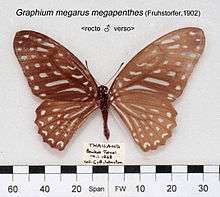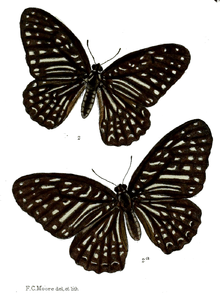Graphium megarus
Graphium megarus, the spotted zebra, is a species of swallowtail butterfly found in Southeast Asia. It is common and not considered to be threatened; however, the nominate subspeciesis protected by law in India.[1]
| Spotted zebra | |
|---|---|
 | |
| G. m. megapenthes front/back | |
| Scientific classification | |
| Kingdom: | |
| Phylum: | |
| Class: | |
| Order: | |
| Family: | |
| Genus: | |
| Subgenus: | Pathysa |
| Species: | P. megarus |
| Binomial name | |
| Graphium megarus Westwood, 1841 | |
| Synonyms | |
| |
Description

Male upperside black with the following white streaks and spots. Forewing cell with a small spot at base followed by three obliquely transverse streaks in middle, none extended to either the subcostal or median veins, and two spots near apex; single slender narrow streaks in interspaces la and 2, and two streaks in interspace 1; above these a spot at base followed by a streak in each of the interspaces 3, 4, 6 and 8, an outer spot only in interspace 5, and a basal spot in interspace 7; finally, a complete series of small subterminal spots. Hindwing: a streak in cell with a spot above its outer apex; a streak followed by a spot in each of the interspaces 1, 6 and 7; three elongate spots in interspaces 2 and 3 and two in interspaces 4 and 5; finally, a series of four slender subterminal lunules in interspaces 2 to 5. Underside similar, with similar but slightly broader markings. Female similar, ground colour duller, more fuliginous black; markings similar, on the forewing slightly broader, on the hindwing slightly narrower, than in the male.[2]
Subspecies
- G. m. megarus
- G. m. megapenthes
- G. m. sagittiger
- G. m. fleximacula
- G. m. marthae
- G. m. tiomanensis
See also
| Wikimedia Commons has media related to Graphium megarus. |
| Wikispecies has information related to Graphium megarus |
References
- Collins, N. Mark; Morris, Michael G. (1985). Threatened Swallowtail Butterflies of the World: The IUCN Red Data Book. Gland & Cambridge: IUCN. ISBN 978-2-88032-603-6 – via Biodiversity Heritage Library.
- Bingham, C.T. (1907). The Fauna of British India, Including Ceylon and Burma. II (1st ed.). London: Taylor and Francis, Ltd.